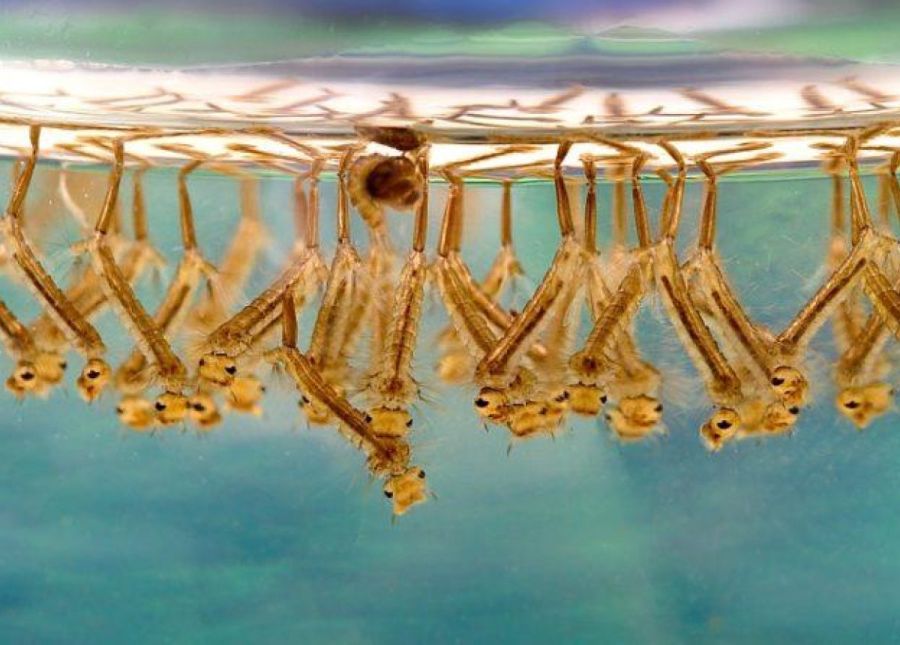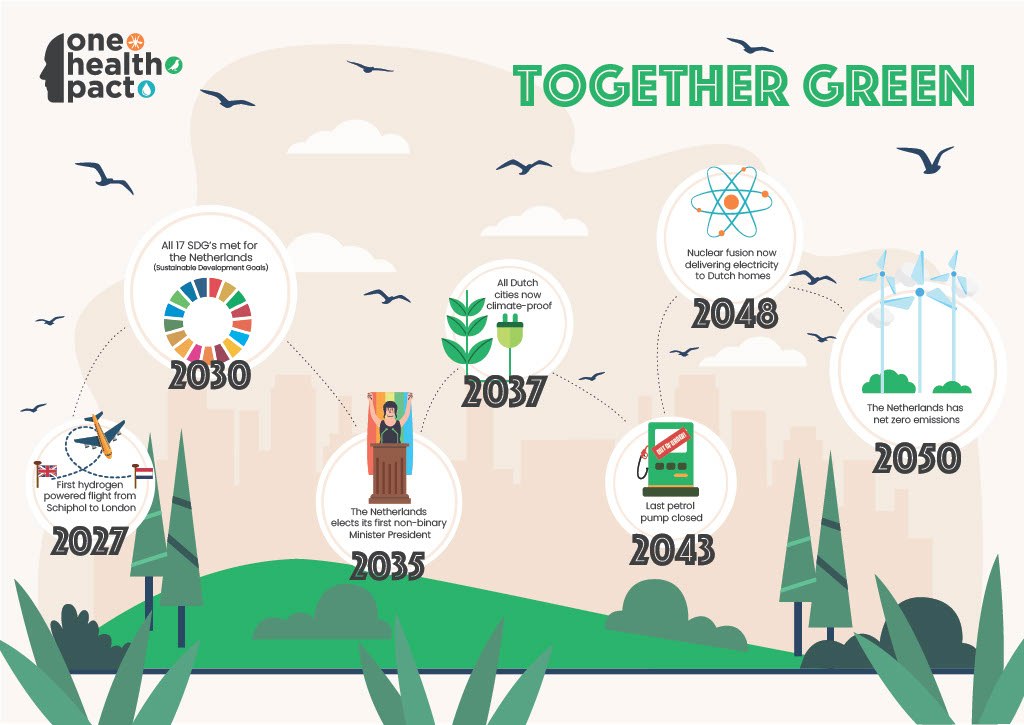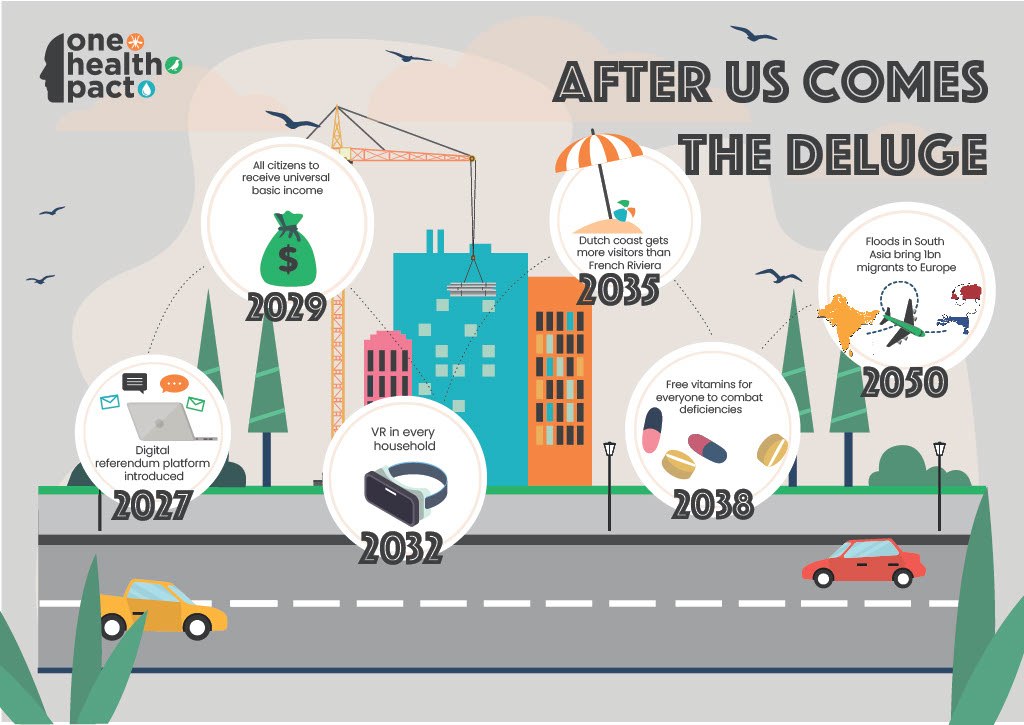How does climate change affect our health? Knowledge-based scenarios created.

For full Dutch translation – read below
Source: Deltares
Publication date of the article: January 31, 2024
Our world is changing, both in terms of climate and socioeconomics. Changes that can have a significant impact on the health of humans, animals, and the environment. We often refer to this as ‘One Health.’ The new paper, ‘Creating the Dutch One Health Shared Socio-economic Pathways (SSPs),’ provides insight into where and when we need to intervene to prevent health damage.
Humans, animals, and the environment are closely interconnected, and to discover realistic future vulnerabilities, we need to consider them together. We need comprehensive scenarios that encompass a wide range of variables affecting One Health. Post-doc Martha Dellar, a freshwater and ecology expert at Deltares and a researcher at Leiden University, has developed a method to create One Health scenarios at the national level. She applied the global Shared Socio-economic Pathways (SSPs) to the Netherlands.
Input needed from involved expertise areas
Dellar is particularly interested in mosquito populations, how they might change in the future, and how this affects the risk of diseases. “To understand this better, we need to know how the Netherlands could change. Changes in climate, demography, technology, and agriculture, for example. Many factors are uncertain.” That’s why Dellar and her co-authors devised four specific scenarios to understand different dimensions of uncertainty and to identify possible health risks.
Dellar: “I collaborated with other experts in the One Health PACT at Leiden University, Deltares, Wageningen University, and the KNMI. But we also sought expertise within the government and the business sector through workshops and surveys. Our scenarios needed input from stakeholders with different expertise.”
Combining all the input helped create storylines for each of the four scenarios. Information from previously developed scenarios by PBL, the Netherlands Environmental Assessment Agency, and Deltares was incorporated. Existing plans and obligations were also considered, along with how they would likely play out in each scenario. Finally, the authors were able to create detailed descriptions for each scenario up to 2050, covering demographics, economy, technology, agriculture, lifestyles, health, and more.

Anticipation of various health risks in the Netherlands
Dellar: “The scenarios can be used by various researchers because our project is designed in a very broad, general way. You can use them to examine different health risks in the Netherlands. For example, if you are interested in mosquito-borne diseases, Louie Krol from Leiden University has developed a very nice model to predict mosquito populations in the Netherlands. We use the scenarios as input to predict how those populations might change over time. Similarly, Mariken van de Wit from Wageningen University looks at the West Nile virus and how the risk of outbreaks might develop in the future according to each scenario.”
All descriptions are in the paper that has just been published. Although the scenarios are at the national level, the local context, policies, and habits can be taken into account. In short, it is a valuable tool to protect us against diseases resulting from climate change.

Land use maps in the next paper
Furthermore, we have gone a step further and looked at possible health risks for each scenario, such as new outbreaks of infectious diseases, pollution, and floods. We have also developed land use maps for each scenario. This is described in our next paper, where we show how land use in the Netherlands will change over the next 30 years. These maps are particularly suitable for modelers who want to use our scenarios because they provide more detail.
Full dutch translation
Bron: Deltares
Publicatiedatum artikel: 31 januari 2024
Onze wereld verandert, zowel op het gebied van klimaat als sociaaleconomisch. Veranderingen die een behoorlijke invloed kunnen hebben op de gezondheid van mens, dier en milieu. We noemen dat vaak ‘One Health’. De nieuwe paper ‘Creating the Dutch One Health Shared Socio-economic Pathways (SSPs)’ geeft ons inzicht waar en wanneer we moeten ingrijpen om gezondheidsschade te voorkomen.
Mensen, dieren en het milieu zijn nauw met elkaar verbonden en om realistische toekomstige kwetsbaarheid te ontdekken moeten we ze samen in beschouwing nemen. We hebben uitgebreide scenario’s nodig die een breed scala aan variabelen omvatten die van invloed zijn op One Health. Post-doc Martha Dellar, zoetwater- en ecologie-expert bij Deltares en onderzoeker aan de Universiteit Leiden, heeft een methode ontwikkeld om One Health-scenario’s op nationaal niveau te maken. Ze heeft de de wereldwijde Shared Socio-economic Pathways (SSP’s), toegepast op Nederland.
Input nodig van betrokken expertisegebieden
Dellar is zelf vooral geïnteresseerd in muggenpopulaties, hoe deze in de toekomst zouden kunnen veranderen en hoe dit het risico op ziekten beïnvloedt. “Om dit beter te begrijpen, moeten we weten hoe Nederland zou kunnen veranderen. Veranderingen in klimaat, demografie, technologie en landbouw bijvoorbeeld. Veel factoren zijn onzeker”. En daarom bedachten Dellar en haar coauteurs vier specifieke scenario’s om de verschillende dimensies van onzekerheid te begrijpen en om mogelijke gezondheidsrisico’s vast te stellen.
Dellar: “Ik heb samengewerkt met andere experts in One Health PACT van de Universiteit Leiden, Deltares, Wageningen Universiteit en het KNMI. Maar we zochten ook expertise binnen de overheid en het bedrijfsleven via workshops en enquêtes. Onze scenario’s hadden de inbreng nodig van betrokkenen met verschillende expertises”.
Het combineren van alle input hielp bij het creëren van verhaallijnen voor elk van de vier scenario’s. Informatie van eerder ontwikkelde scenario’s van PBL, Planbureau voor de Leefomgeving en Deltares werd verwerkt. Tevens werd rekening gehouden met bestaande plannen en verplichtingen, hoe deze waarschijnlijk zouden uitpakken in elk scenario. Tot slot waren de auteurs in staat om gedetailleerde beschrijvingen te maken voor elk scenario tot 2050, waarin demografie, economie, technologie, landbouw, levensstijlen, gezondheid en meer aan bod komen.

Vooruitblik op verschillende gezondheidsrisico’s in Nederland
Dellar: “De scenario’s kunnen door verscheidene onderzoekers worden gebruikt omdat ons project op een heel brede, algemene manier is opgezet. Je kunt ze gebruiken om verschillende gezondheidsrisico in Nederland te bekijken. Als je bijvoorbeeld geïnteresseerd bent in door muggen overgebrachte ziekten, dan heeft Louie Krol, van de Universiteit Leiden, een heel mooi model ontwikkeld om muggenpopulaties in Nederland te voorspellen. We gebruiken de scenario’s als input om te voorspellen hoe die populaties in de loop van de tijd zouden kunnen veranderen. Op dezelfde manier kijkt Mariken van de Wit van de Wageningen Universiteit naar het West-Nijlvirus en hoe het risico op uitbraken zich in de toekomst volgens elk scenario zou kunnen ontwikkelen”.
Alle beschrijvingen staan in de paper die zojuist is gepubliceerd. Hoewel het scenario’s op nationaal niveau zijn, kan er rekening worden gehouden met de lokale context, het beleid en de gewoonten. Het is kortom een waardevol hulpmiddel om ons tegen ziektes die het gevolg zijn van klimaatverandering te beschermen.

Kaarten van landgebruik in de volgende paper
We zijn overigens nog een stap verder gegaan en hebben bij elk scenario gekeken naar mogelijke gezondheidsrisico’s, zoals nieuwe uitbraken van infectieziekten, vervuiling en overstromingen. We hebben ook kaarten van het landgebruik ontwikkeld voor elk scenario. Dit wordt beschreven in onze volgende paper. We laten daarin zien hoe het landgebruik in Nederland de komende 30 jaar zal veranderen. Deze kaarten zijn bij uitstek geschikt voor modelleurs die onze scenario’s willen gebruiken, omdat ze meer detail bevatten.